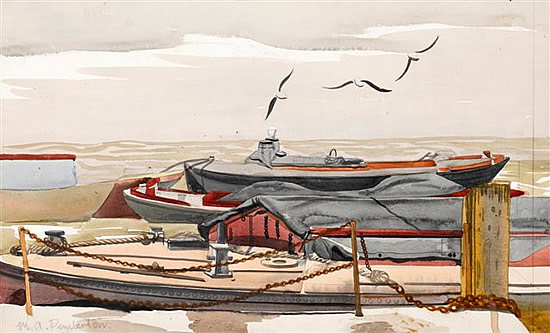
Docked boats
Mounted (ref: 4454)
Signed, inscribed with '2' bottom left
Watercolour, 14 1/2 x 21 in. (35.5 x 53.5 cm.)

Signed, inscribed with '2' bottom left
Watercolour, 14 1/2 x 21 in. (35.5 x 53.5 cm.)
Provenance: The Artist's Estate; Private collection
In 1925, at the age of 15, Muriel entered the local school of art at Burslem, in the Potteries, as its youngest student. While many contemporaries, including two of her sisters, trained as designers and decorators of ceramics, she was determined to become a proper artist and, in 1928, succeeded in gaining a scholarship and a major award to the School of Painting at the Royal College of Art. And yet, while the conditions and purposes of a provincial school of art had made her idealise the art of painting, a breakdown of the divisions between the four schools of the Royal College encouraged her to develop the more interdisciplinary approach which prepared her for her working life.
During the first summer vacation, a chance encounter helped Muriel Pemberton to realise that her aptitude for fashion would help her to maintain herself as an artist. While out walking in Stoke, a woman inquired as to where she had bought the dress that she was wearing, a dress that she had actually designed and made herself. On her return to the Royal College, she discussed the idea of a diploma in fashion with Ernest Tristram, the Professor of Design, and he allowed her to take such a course should she be able to develop it for herself. She did so by assembling three elements: she drew beautifully designed dresses in rich fabrics at Reville and Rossiter, Court Dressmaker to Queen Mary; she studied cutting at the Katinka School (paid for with lessons in design); and she read a number of books on the history of costume as recommended to her by James Laver.
As a result of her inspiration and initiative, Pemberton was awarded the first Diploma in Fashion by the Royal College of Art in 1931, and immediately began to teach fashion drawing two days a week at St Martin's School of Art. Almost solely through her own efforts, this part- time position was expanded into the important role of head of the first Faculty of Fashion and Design in Britain.
She then taught in the knowledge that the majority of her students were developing along her own path, from painting to design, and therefore had previously gained little practical experience of workshop and salon. She responded to their various needs and abilities by encouraging them to cultivate her own experimental attitude. For instance, she encouraged them to produce free and fluent lines by looking continually at the model rather than their paper, and sometimes banished pencils, offering instead the thick and colourful media of oil pastel and paint mixed with soap powder.
Many of the students who passed through St Martin's School of Art have paid tribute to Pemberton's liberating influence, which contrasted with the more conventional teaching of other members of staff. If it did not always prepare them for the politics and economics of the rag trade, it gave them an ideal to which to aspire, and those who were as determined as Pemberton herself, such as Katherine Hamnett and Bruce Oldfield, both altered the face of British fashion and helped to make London a centre of fashion design as well as of tailoring.